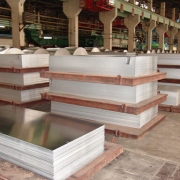The difference between 1050, 1060, 1070 and 1100 aluminum plates
Aluminum sheets are widely used in various industries due to their unique properties such as light weight, high strength, and excellent corrosion resistance.
Of the various aluminum alloys available, the 1050, 1060, 1070 and 1100 aluminum alloy are the most popular choices.
But do you know the differences between 1050, 1060, 1070 and 1100 aluminum plates?
1050 aluminum sheet
1050 aluminum plate is a pure aluminum alloy with an aluminum content of more than 99.5%. It is highly ductile and offers excellent processability, electrical conductivity and corrosion resistance. Due to its high purity, it is commonly used in applications such as capacitors, chemical storage, roofing and decking materials.
1060 aluminum sheet
1060 aluminum plate is also a pure aluminum alloy with a slightly higher aluminum content, reaching more than 99.6%. It contains small amounts of copper, which gives it better strength and thermal conductivity than 1050 alloy. This alloy is commonly used in reflectors, lighting fixtures, pressure vessels and radiators.
1070 aluminum sheet
The aluminum content of 1070 aluminum plate is more than 99.7%, and it contains higher amounts of copper and manganese than 1060 alloy. It has high electrical and thermal conductivity, making it ideal for wire and cable applications as well as heat exchangers and evaporators.
1100 aluminum sheet
The aluminum content of 1100 aluminum plate is more than 99% and contains a small amount of copper, similar to 1060 alloy. It has excellent forming, welding and corrosion resistance properties, making it suitable for a wide range of applications including parts, sheets and castings.
In conclusion,To sum up, the difference between 1050, 1060, 1070 and 1100 aluminum alloy sheets lies in their aluminum content and the content of other elements such as copper and manganese.
These differences result in varying degrees of strength, conductivity, and corrosion resistance, making each alloy suitable for specific applications.
By understanding the differences between these aluminum alloys, you can choose the one that best suits your specific project needs.



